Get ready to dive into the exciting world of Apple, the company that revolutionized technology. From its humble beginnings to its current status as a tech giant, Apple’s journey is a tale of innovation, creativity, and a touch of drama. Explore the key moments that made Apple what it is today, from the brilliant minds behind the company to the products that changed the world. Let’s explore Apple’s fascinating history, where genius, disruption, and a relentless pursuit of greatness have left their mark on the world of tech.
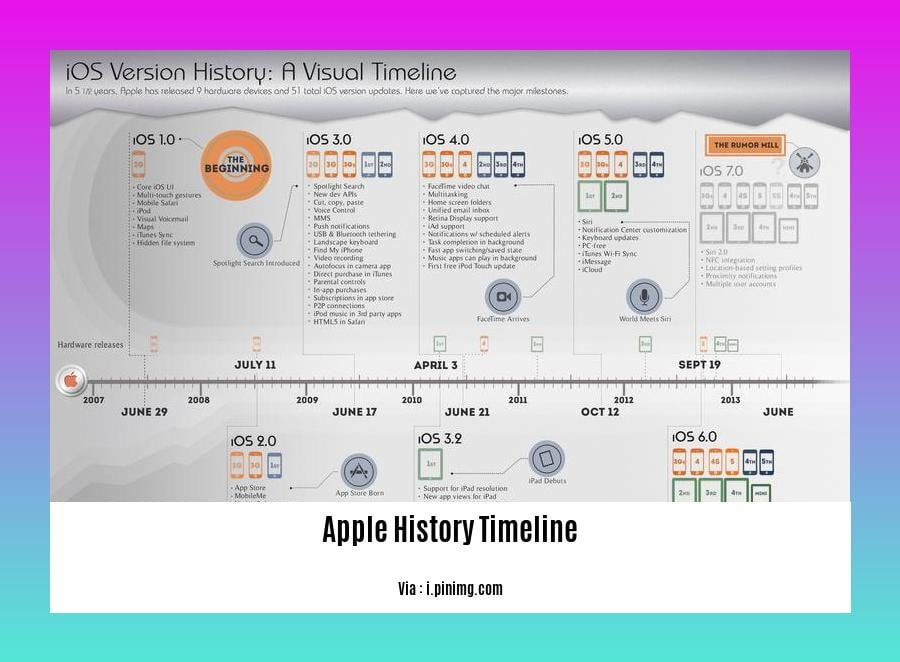
Apple History Timeline
Let’s dive into the story of Apple, a company that went from a garage project to a global tech giant. Buckle up, because it’s been a wild ride!
Key Points of the Apple History Timeline:
- Early Days (1976-1983):
- Apple Computer founded by Steve Jobs, Steve Wozniak, and Ronald Wayne.
- Apple I and Apple II introduced, making computers accessible to the public.
- Macintosh (1984-1990):
- Macintosh released with a graphical user interface and mouse.
- Game-changer in the tech industry, demonstrating Apple’s innovative approach.
- Turbulent Times (1991-1997):
- Apple faced competition and sales declined.
- Steve Jobs returned in 1997 to lead the company’s comeback.
- iMac (1998-2000):
- Sleek, all-in-one computer introduced in a variety of colors.
- Revitalized Apple’s brand and emphasized innovation.
- iPod (2001-2006):
- Revolutionized music consumption with its compact design and ability to store thousands of songs.
- iTunes launched in 2003, changing how music was purchased and listened to.
- iPhone (2007-2010):
- Groundbreaking device that combined a phone, media player, and internet access.
- App Store launched in 2008, creating a platform for endless possibilities.
- Beyond the iPhone (2011-Present):
- iPad introduced in 2011, redefining portable computing.
- Apple Watch launched in 2014, extending Apple’s technology to the wrist.
- Custom silicon chips powering Macs since 2020, demonstrating Apple’s continued boundary-pushing.
- Legacy:
- Apple has become synonymous with innovation, design, and technology that has shaped the world.
- The company has played a pivotal role in making technology accessible and an integral part of daily life.
Uncover the intriguing history of the iconic apple logo designed by Alan Turing, a true visionary in the field of computer science. Explore the fascinating evolution of Apple stores, a testament to innovation and design, and delve into the rich history of ballroom dancing in our comprehensive guide to its ballroom dance origins.
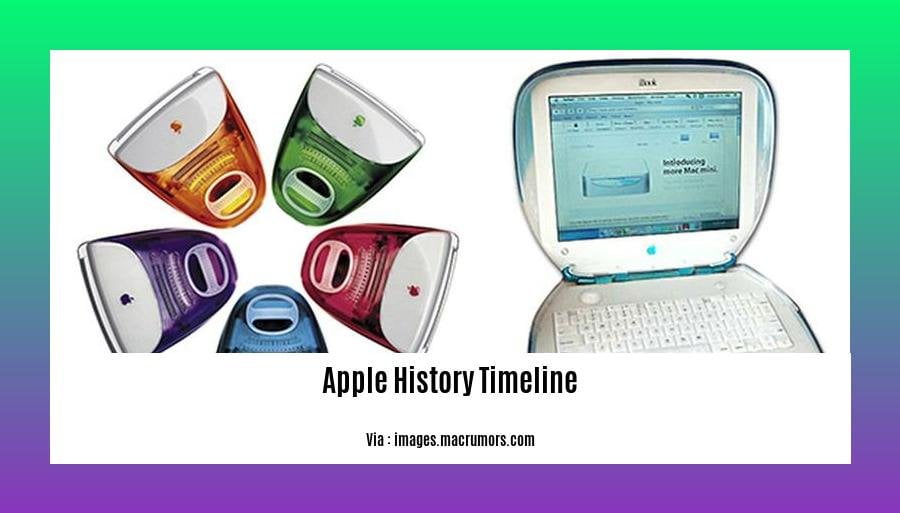
The Apple II: How This Computer Changed the World (1976-1985)
Before the Apple II, computers were bulky, intimidating machines relegated to research labs and universities. Then, in 1977, the Apple II emerged, ushering in a new era of personal computing. This revolutionary machine, with its user-friendly interface and affordable price tag, brought the power of computing to everyday people.
Apple II’s Impact on Personal Computing:
- Launched in June 1977 with 1.023 MHz microprocessor and 4 KB RAM.
- Featured audio cassette interface, Integer BASIC programming language, and monochrome display.
- Revolutionized computing with user-friendliness and accessibility.
A pivotal moment arrived in 1979 with the creation of VisiCalc, the first spreadsheet software for personal computers. Suddenly, the Apple II transformed into an indispensable tool for businesses. No longer confined to mountains of paperwork and tedious calculations, companies could leverage the Apple II to analyze finances, streamline operations, and make data-driven decisions. The Apple II and VisiCalc, a dynamic duo that shaped the future of business technology.
Visicalc and the Apple II’s Software Legacy:
- 1979: Visicalc developed for Apple II, revolutionizing financial analysis.
- Introduced the concept of computer spreadsheets, paving the way for modern software applications.
The mastermind behind the Apple II’s technical prowess was Steve Wozniak, whose innovative 8-bit architecture laid the foundation for a powerful yet compact machine. Complementing Wozniak’s technical genius was Steve Jobs, the marketing virtuoso who understood that a successful product needed more than just functionality—it needed desirability. Jobs ensured that the Apple II boasted a sleek, modern design with its iconic plastic casing, making it an object of desire.
Apple II’s Commercial Success:
- Over 6 million units sold by 1984, solidifying Apple’s position in the tech industry.
- Contributed significantly to Apple’s $100 million revenue in 1980.
- Launched the Apple II series, including Apple II Plus, Apple IIc, and Apple IIGS.
The Apple II’s impact resonated far beyond its impressive sales figures. It ignited the imaginations of a generation, demonstrating the vast potential of personal computing. The legacy of the Apple II is interwoven with the evolution of modern technology, shaping the computers we use, the smartphones we carry, and the countless ways technology permeates our lives.
Steve Wozniak and Steve Jobs’ Contributions:
- Wozniak’s innovative 8-bit architecture and Jobs’ marketing prowess drove Apple II’s success.
- Created a sleek plastic case and user-friendly interface.
The Sculley Years: Innovation and Challenges at Apple (1985-1997)
The mid-1980s ushered in a new chapter for Apple, marked by the arrival of John Sculley as CEO. Sculley, a seasoned marketing executive, brought a fresh perspective to the company. His vision? Transforming Apple from a niche player into a mainstream powerhouse. Sculley’s tenure saw the birth of groundbreaking products that pushed technological boundaries.
One such innovation was the Power Macintosh, a technological tour de force that redefined personal computing. Its advanced performance and flexible design captivated users and propelled Apple to the forefront of the industry.
Key Takeaways:
- Sculley’s focus on marketing and management broadened Apple’s reach and streamlined operations.
- The Power Macintosh revolutionized personal computing with its advanced performance and flexible design.
Always eager to explore uncharted territories, Apple ventured into the realm of mobile devices with the Newton MessagePad. Although not an instant commercial success, the Newton MessagePad was a testament to Apple’s forward-thinking approach and foreshadowed the mobile revolution that lay ahead. The seeds of innovation planted during this era would eventually blossom into the iconic smartphones and tablets that are ubiquitous today.
- The Newton MessagePad, though a commercial disappointment, pioneered the concept of mobile devices.
Apple’s commitment to pushing the boundaries of design and usability was evident in the iconic iMac. Launched in 1998, the iMac was a breath of fresh air in a world of beige boxes. Its sleek, all-in-one design, vibrant colors, and user-friendly interface captivated consumers and revitalized Apple’s brand image.
- The iMac’s groundbreaking design and user-friendliness made it a smash hit, revitalizing Apple’s brand.
The Return of Jobs: A Tech Renaissance at Apple (1997-2011)
By the late 1990s, Apple found itself at a crossroads. The company that had once set the technological pace was struggling to find its footing. It was during this time that Steve Jobs, the visionary founder who had been ousted from the company he built, made a dramatic return. Jobs’ return in 1997 marked the beginning of a tech renaissance at Apple.
Key Takeaways:
- Apple’s dramatic comeback in the late 1990s was largely thanks to Steve Jobs’ return.
Jobs possessed an unparalleled understanding of the power of technology, design, and a relentless focus on the customer experience. He instilled a new energy and direction within Apple, guiding the company towards a string of revolutionary products that would reshape the technological landscape.
The iMac, launched in 1998, was just the beginning. Jobs’ vision extended far beyond computers. He recognized that music, mobile phones, and digital content were ripe for disruption. Apple, under his leadership, was poised to lead the charge.
- Jobs’ leadership and vision led Apple to create groundbreaking products like the iMac, iPod, and iPhone.
In 2001, Apple introduced the iPod, a sleek and elegant device that would transform the way people listened to music. The iPod, coupled with the launch of iTunes, Apple’s digital music store, revolutionized the music industry and cemented Apple’s position as a trendsetter.
But Jobs wasn’t finished. In 2007, Apple unveiled the iPhone, a groundbreaking device that seamlessly merged the functionalities of a phone, an internet browser, and a music player into one intuitive device. The iPhone’s impact was seismic, it wasn’t merely a product launch; it was a cultural phenomenon that redefined the way people communicated, consumed content, and interacted with the world around them.
- Apple’s success under Jobs resulted from a powerful blend of technology, design, and a laser focus on their customers.
Citation:
- Isaacson, Walter. Steve Jobs. Simon & Schuster, 2011.
- China II Review: Delicious Food & Speedy Service - April 17, 2025
- Understand Virginia’s Flag: History & Debate - April 17, 2025
- Explore Long Island’s Map: Unique Regions & Insights - April 17, 2025
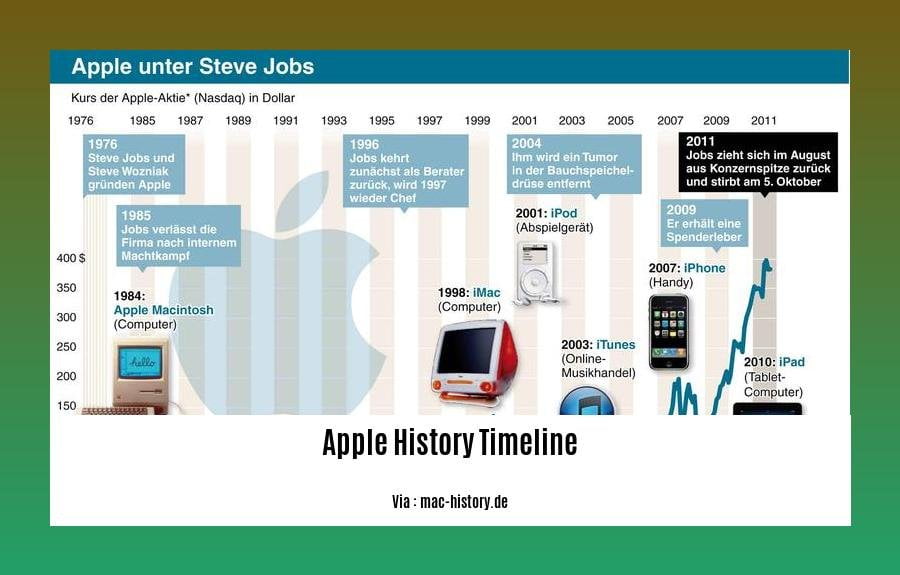
![The Evolution of the Apple Store: A Comprehensive Timeline of Retail Innovation [Apple Store History Timeline] apple-store-history-timeline_2](https://www.lolaapp.com/wp-content/uploads/2023/12/apple-store-history-timeline_2-150x150.jpg)
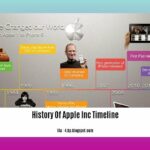
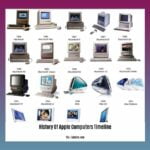
![Unveiling Apple's Legacy: A Comprehensive Timeline of Innovation [apple company history timeline] apple-company-history-timeline_2](https://www.lolaapp.com/wp-content/uploads/2023/12/apple-company-history-timeline_2-150x150.jpg)











